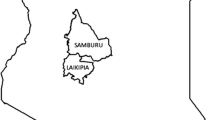Access this chapter
Tax calculation will be finalised at checkout
Purchases are for personal use only
Similar content being viewed by others
Notes
- 1.
Functional types/groups rely on role of plants within an ecosystem as opposed to phylogenetic groupings. Two meanings are found in the literature. One meaning focuses on species that respond in a similar way to environmental perturbations, while the second usage groups together species that have similar effects on ecosystem-level processes.
- 2.
States in this context refers to a stage, at a given point of time, in the successional changes in plant communities that follow perturbations like drought, overgrazing etc (see Box 2).
References
Anand M, Li BL (2001) Spatiotemporal dynamics in a transition zone: patchiness, scale, and an emergent property. Community Ecol 2(2):161–169
Ash AJ, Stafford-Smith DM (1996) Evaluating stocking rate impacts in rangelands: Animals don’t practice what we preach. Rangeland J 18:216–243
Bao Y-J, Li Z-H, Zhong Y-K (2004) Compositional dynamics of plant functional groups and their effects on stability of community ANPP during 17yr of mowing succession on Leymus chinensis Steppe of Inner Mongolia, China. Acta Bot Sin 46:1155–1162
Behnke RH, Abel NOJ (1996) Revisited: the overstocking controversy in semi-arid Africa, World Animal Review 87:3–27
Behnke RH, Scoones I, Kerven C (eds) (1993) Range Ecology at disequilibrium: New models of natural variability and pastoral adaptation in African savannas. Overseas Development Institute, London
Briske DD, Bestelmeyer BT, Stringham TK, Shaver PL (2008) Recommendations for development of resilience-based state-and-transition models. Rangeland Ecol Manage 61:359–367
Dalintai A (2005) Rethinking grassland desertification. J Coll Finance Econ Guizhou 3:46–50 (in Chinese)
FAO 1995 Livestock: a driving force for food security and sustainable development. Feed Res. Group, FAO, Rome WAR/RMZ 84–85
Heshmati GA, Squires VR (2009) New thinking in range ecology. In: Squires VR (ed) Range and animal sciences and resources management, EOLSS/UNESCO
Hodgkinson KC (1995) A model for perennial grass mortality under grazing. In: West NE (ed) Rangelands in a sustainable biosphere. Proceedings of the IVth International Rangeland Congress, vol 1, Society for Range Management, Denver, CO, pp 240–241
Hua LM, Michalk DL (2010) Herders’ income and expenditure: perceptions and expectations (Chapter 11, this volume)
Kirychuk B, Fritz B (2010) Ecological restoration and control of Rangeland degradation: Livestock management, (Chapter 4, this volume)
Le Houérou HN (1984) Rain use efficiency: A unifying concept in arid-land ecology. J Arid Environ 7:213–247
Li X (2009) Mechanisms of degradation in grazed rangelands. In: Squires V, Lu X, Lu Q, Wang T, Yang Y (eds) Degradation and recovery in China’s pastoral lands. CABI, Wallingford, pp 45–60
Long R, Shang Z, Li X, Jiang P, Jia H, Squires VR (2010) Carbon sequestration and the implications for rangeland management (Chapter 7, this volume)
Lu Q, Wang S, Squires V, Yang Y (2005) Desertification and dust storms in China: Impacts, root causes and mitigation strategies. China Forestry Sci Technol 5(3):22–35
Lu Q, Wang X, Wu B (2009) An analysis of the effects of climate variability in northern China over the past five decades on people, livestock and plants in the focus area. In V. Squires et al., (eds) Rangeland degradation and recovery in China’s pastoral lands. CABI, Wallingford UK pp 33–44
Michalk DL, Hua LM, Kemp DR, Jones R, Takahashi T, Wu JP, Nan Z, Xu Z, Han G (2010) Redesigning livestock systems to improve household income and reduce stocking rates in China’s western grasslands (Chapter 14, this volume)
Reynolds JF, Stafford Smith, DM (eds) (2002) Global desertification: Do humans cause deserts? Dahlem Workshop Report 88, Dahlem University, Berlin, pp 1–21
Squires VR and Hua L (2010a) (Chapter 1, this volume)
Squires VR, Hua L, Li G, Zhang D (2010b) Exploring the options in North-west China pastoral lands (Chapter 3, this volume)
Squires VR, Hua L, Zhang D, Li G (2010b) Towards ecological restoration and management in China’s northwest pastoral zone (Chapter 15, this volume)
Squires VR, Lu X, Lu Q, Wang T, Yang Y (2009) Rangeland degradation and recovery in China’s pastoral lands. CABI, Wallingford UK p 264
Thomas D, Squires VR (1990) Available soil moisture as a basis for land capability assessment in semi arid regions. Vegetatio 91:183–190
Westoby MB, Walker B, Noy-Meir I (1989) Opportunistic management for rangelands not at equilibrium. J Range Manage 42:266–274
Winrock International (1992) Assessment of Animal Agriculture in Sub-Saharan Africa. Winrock International. Arkansas, USA
Zhao CZ and Squires VR (2010) (Chapter 6, this volume)
Author information
Authors and Affiliations
Corresponding author
Editor information
Editors and Affiliations
Rights and permissions
Copyright information
© 2010 Springer Science+Business Media B.V.
About this chapter
Cite this chapter
Squires, V., Degang, Z., Limin, H. (2010). Ecological Restoration and Control of Rangeland Degradation: Rangeland Management Interventions. In: Squires, V., Hua, L., Li, G., Zhang, D. (eds) Towards Sustainable Use of Rangelands in North-West China. Springer, Dordrecht. https://doi.org/10.1007/978-90-481-9622-7_5
Download citation
DOI: https://doi.org/10.1007/978-90-481-9622-7_5
Published:
Publisher Name: Springer, Dordrecht
Print ISBN: 978-90-481-9621-0
Online ISBN: 978-90-481-9622-7
eBook Packages: Biomedical and Life SciencesBiomedical and Life Sciences (R0)




